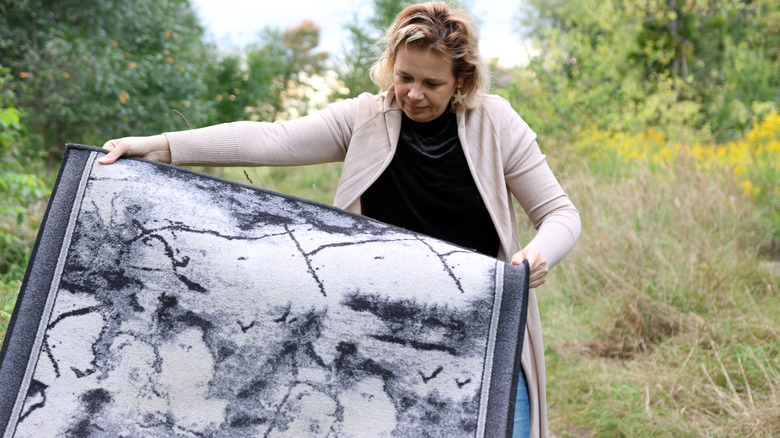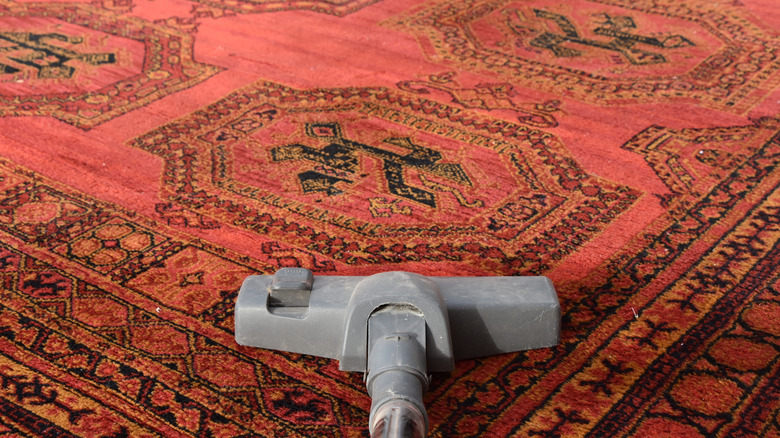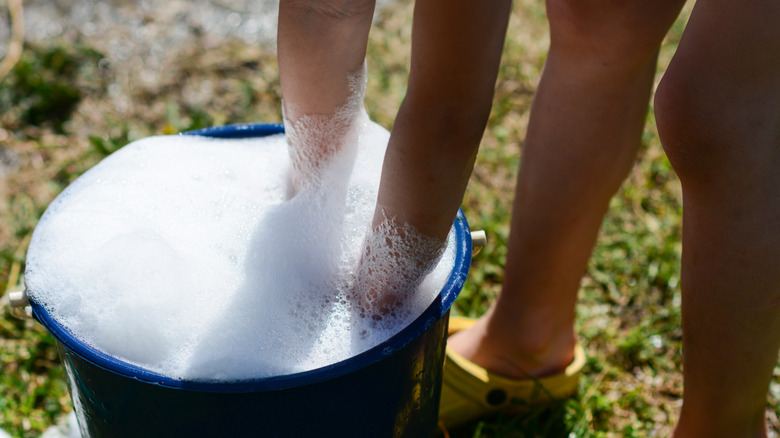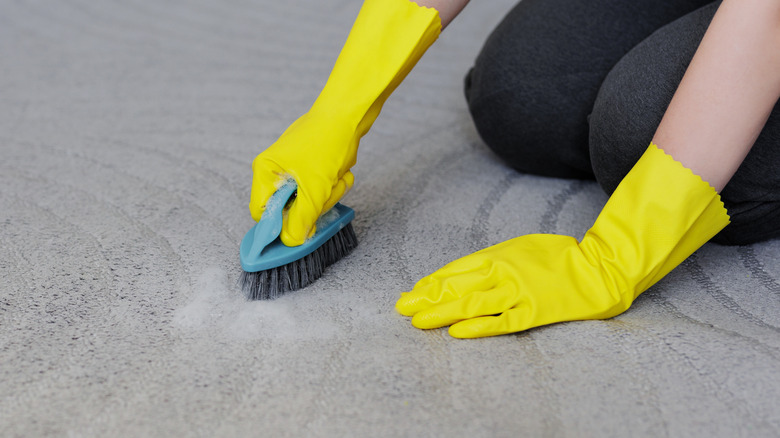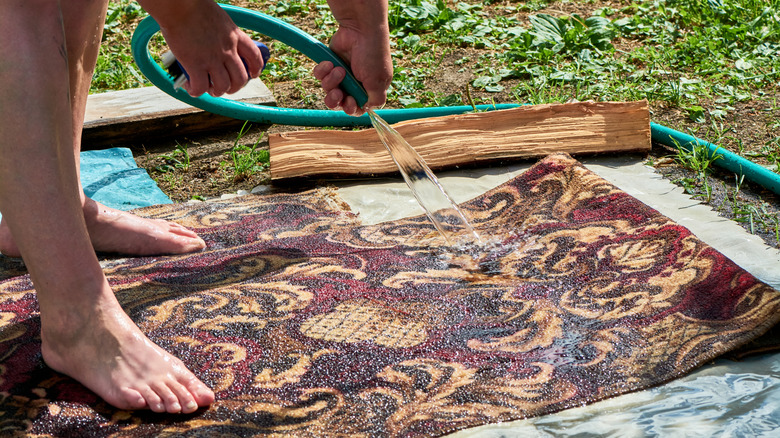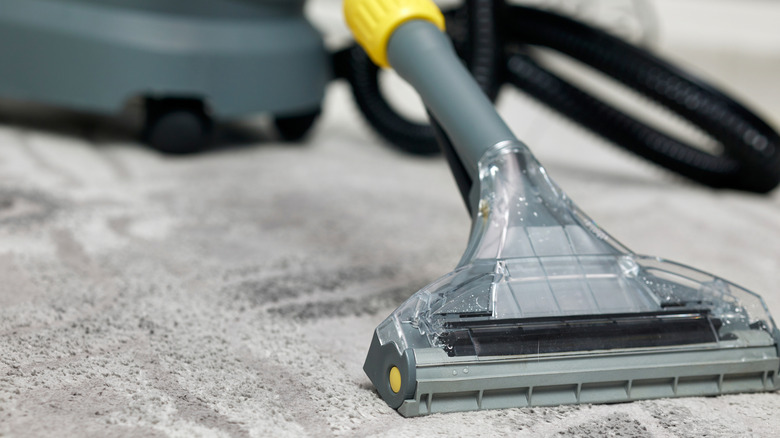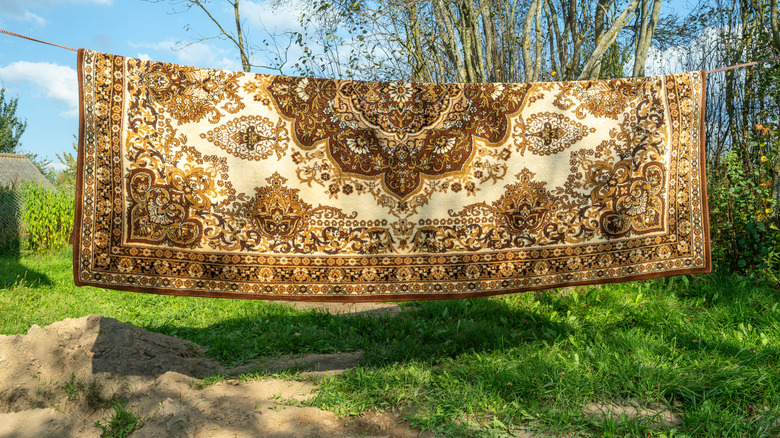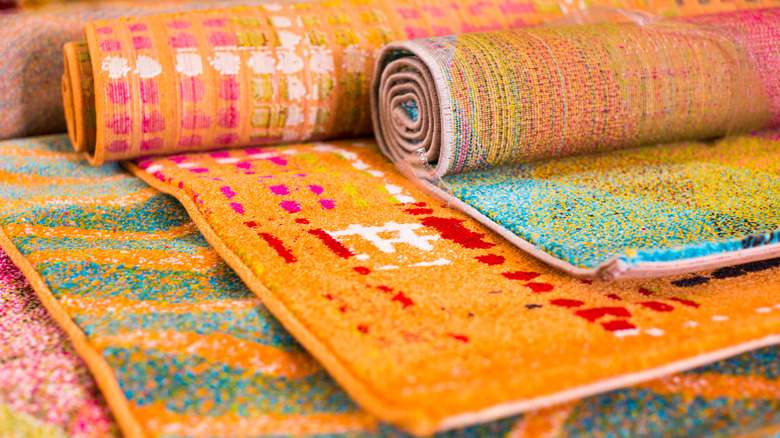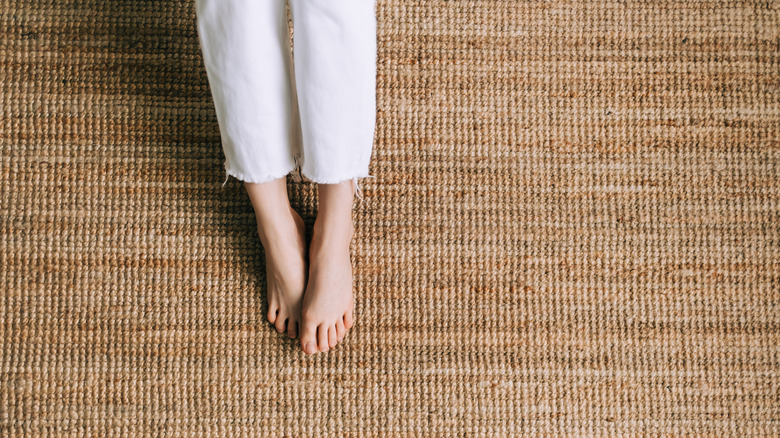How To Wash A Rug Yourself In 10 Steps Or Less
We may receive a commission on purchases made from links.
Rugs make up a part of the classic home decor trends that stand the test of time — they add texture, color, and warmth to your space. That being said, keeping them clean and odor-free can feel like an enormous task. Professional rug cleaning can cost anywhere from $80 to $400, depending on the size, material, and how soiled it is. While hiring a professional is an option, you can also clean your rugs yourself at home and keep them looking fresh without spending a fortune.
With some simple steps and a little patience, it's easy to remove dirt, lift stains, and refresh fibers without damaging your rug. You can choose between some of the best-selling cleaning solutions or even mix your own from scratch. Whether you're tackling a high-traffic wool runner or a delicate jute area rug, DIY rug cleaning lets you maintain their beauty and longevity so they can keep making your home a cozy, inviting space. Here are some game-changing tips to keep your rugs pristine.
Gather all your rug cleaning supplies for convenience
You don't want to start washing your rug, only to realize your cleaning supplies are out of reach. Before you begin washing your rug, have all your tools and products within arm's reach to save you from tracking water and soap across your house mid-clean. Begin by grabbing your vacuum cleaner with a brush attachment to remove dirt before washing, a soft-bristled brush for scrubbing, and a rug shampoo or carpet cleaner that's suitable for your rug's material. If you have access to one, a wet-dry vacuum can make rinsing and drying easier (though it's optional). Keep a bucket of clean water and a few microfiber cloths nearby for rinsing and blotting.
For added convenience, place all your cleaning products in a portable caddy to easily move them around as you work. It's a good idea to wear rubber gloves while washing your rug to protect your hands from your chosen cleaning solutions and the friction that'll be created while you're scrubbing. If you're washing a bigger or very soiled rug, you may want to consider having a small stool or kneeling pad ready to stay comfortable while you tackle the work.
Take your rug outdoors to make cleaning easier
When it comes to washing a rug yourself, having enough space to work in and good airflow are essential, which is why moving the item outdoors is best. Cleaning your rug outside means you'll have plenty of room to scrub, rinse, and dry your rug thoroughly. You can avoid worrying about water splashing onto your home's flooring, which can damage it if it's not moisture-resistant. Before moving your rug, remove any furniture or decor sitting on it, and then roll it up, rather than dragging it across your floor. This helps prevent damage to the backing or edges of the rug.
Choose a sunny, dry day to wash your rug so it can dry naturally in the fresh air once you've finished cleaning it. Choose a flat, clean surface outside, like your patio or driveway, depending on the size of your rug. Avoid placing your rug over grassy or muddy areas to clean it, as this can transfer dirt or moisture back onto it. If the ground you're placing your rug onto is rough, place a tarp or plastic sheet over it to prevent snags and any detergent runoff. Consider beating your rug before washing it to loosen any trapped dust and pet hair — this will make the rest of your cleaning steps more effective.
Do an initial vacuum of your rug to remove dirt and debris
Before you wet your rug, it's best to give it a thorough vacuum to remove as much dust, hair, and grime as possible. This step prevents any dirt from turning into muddy residue when you start washing your rug. Set up your vacuum outdoors with a long, compatible extension cord so you can move the equipment around freely without having to strain or unplug the machine. Empty the vacuum's canister or bag before you start to make sure it'll suck up as much dirt as possible. Use a soft floor attachment with bristles, as beater bars can significantly damage your rug.. When you vacuum, do so gently and go over the same areas several times to get all the grime out.
It's a good idea to inspect your rug for frayed edges or loose threads to avoid vacuuming over them. You should also adjust the suction on your vacuum based on the materials your rug is made from. For instance, silk or wool rugs that are fragile should only be vacuumed with low suction, while synthetic rugs do fine with medium to high power. You may want to consider vacuuming both sides of shag or high-pile rugs to get rid of dirt stuck on the bottom. For a bigger rug, vacuum it in sections to make sure you don't miss any areas.
Use a carpet shampoo or make a DIY solution
Once you've sucked up all the loose dirt, the next step is to give your rug a deep clean using a carpet shampoo or a DIY detergent. A good carpet shampoo helps remove grime that's embedded in the material and refreshes the rug's fibers, leaving it cleaner and odor-free. Choose from highly rated carpet shampoo options like the P & S Professional Detail Products Carpet Bomber for heavily soiled rugs, Bissell Woolite Advantage for rugs that lie in high-traffic areas, or Capture Carpet & Rug Cleaner for homes with pets.
For a DIY color-safe rug shampoo, mix 1 tablespoon of distilled white vinegar, ½ teaspoon of ammonia, 4 tablespoons of dishwashing liquid, and 2 cups of warm water in a food processor to create a foamy texture. Then, spread the foam evenly across your rug using a soft-bristled brush and allow it to sit for about 10 minutes to break down dirt. Avoid over-saturating the rug with your chosen solution, as too much liquid can seep into its backing, which can spur mold or mildew later on. If you're not sure whether your rug can handle a solution or ingredient like ammonia, check the care label underneath it for any chemicals that it can't withstand.
Conduct a small color test before you get started
Before you apply your chosen cleaning solution to your entire rug, it's a good idea to make sure it won't cause the colors to bleed or the fibers to weaken. Do a small color test on an inconspicuous area of the rug, like along its edge or under the tassels. Apply a small amount of the solution you want to use with a clean cloth or sponge. Then, let it sit for the time recommended in the cleaner's instructions. Afterward, blot your test area gently with a dry towel and check the cloth for any color transfer. If you see dye on your cloth, the cleaner may be too harsh or unsuitable for your rug's material.
When you're doing your color test, always use white cloths or paper towels. Colored fabrics can mask blending or even transfer their own dye to the rug. Make a new batch of your DIY cleaner for the test to make sure all the ingredients are well mixed. If your rug has many colors or intricate patterns, apply the solution to a few small sections, as some dyes may react differently.
Give your rug a good scrub or steam clean it
After you've tested your carpet shampoo, it's time to start cleaning. To get the cleaning solution deep into your rug's fibers, use a soft-bristled brush to gently scrub in circular movements. Don't push too hard, as excess pressure can hurt the rug's fibers. Start with the parts of the rug that are obviously soiled or stained, then clean the rest. After you've scrubbed each area a few times, let the detergent soak for the time indicated on its label. This lets the cleaner work on grime, oil, and odors that are hard to get rid of.
A steam cleaner might be a useful alternative to deep cleaning your rug if you want to do it with less work. Steam cleaning can get rid of up to 97% of dirt and bacteria, which means you don't have to use harsh chemicals to clean deeply. Just remember that steam may damage natural fibers in some rugs or make dyes run, so always read the care label first.
Rinse your rug thoroughly to get all the detergent out
Once you're done scrubbing or steam cleaning, it's essential to remove every last bit of cleaning solution from your rug. This is because leftover soap can attract dirt, make fibers feel stiff, or even cause irreversible damage. The easiest way to make sure your rug is thoroughly rinsed is to use your garden hose at medium pressure while you're already set up outside. Start at one end of the rug and work your way across it in overlapping passes. Continue rinsing your rug until the water runs clear, which means you've washed out all the detergent.
If you have a delicate or older rug, it's best to use your hose on a low-pressure setting and rinse it more gently to protect the fibers. For high-pile or thick rugs, try flipping them over when you're halfway through to rinse them from the other side. This helps to get rid of any extra cleaning solution that may be stuck in the weave.
Do a basic dry of your rug after rinsing it
Once you've thoroughly rinsed your rug, the next step is to start removing as much water from it as possible. A wet-dry vacuum is a great option for getting this step right because it can suck up most of the moisture without damaging the fibers of the rug. Set up the vacuum correctly by checking that a foam filter is attached and that the recovery tank is empty to ensure good suction. Next, move your wet-dry vacuum slowly across your rug in sections. You may also want to use a squidgee to push water toward the edges of your rug to help absorb any additional moisture that the vacuum might not have sucked up.
While you're using your wet-dry vacuum to clean your rug, you'll want to avoid going over a single area too many times. This may harm the fibers or damage the rug's backing. If your rug is quite heavy or thick, go over it from different directions to make sure the water is sucked up from every layer.
Hang your rug out to air dry completely
When you're done removing most of the water, the final step in cleaning your rug yourself is to let it dry completely. If your rug stays even slightly damp, it can cause mold, mildew, and musty odors, or leave moisture on the floor beneath it. The best way to do this is to hang the rug over a sturdy railing, clothesline, or even a couple of chairs. This will let the air circulate around both sides of the rug. Make sure it's supported evenly to prevent stretching or warping. If hanging your rug out to dry isn't possible, use fans or a gentle flow of heated air to speed up the drying process.
Rotate the rug occasionally so all areas dry evenly, especially thick or high-pile sections that tend to retain moisture. If you're going to dry your rug indoors, set up fans to create cross-ventilation and place the rug off the floor so it gets airflow underneath. Avoid walking on or placing furniture on the rug until it's fully dry.
Use less water and specialized carpet shampoo for wool rugs
Wool rugs are the one type of rug that most homeowners prefer because they're usually the easiest to clean yourself. However, they still need care to maintain their texture and longevity. Start by giving the rug a thorough vacuum to remove dirt and debris. Then, wash it using a wool-safe shampoo and avoid harsh chemicals that can damage the natural fibers. After applying a wool cleaning solution, blot excess moisture with towels rather than wringing or twisting the rug. Wool rugs can be safely exposed to sunlight, which helps them dry faster and naturally sanitizes the material. Aim to deep-clean your wool rug every six months to keep it looking fresh and prevent dirt from building up.
For an extra-gentle clean, use one of the best DIY vinegar cleaning solutions by mixing equal parts distilled white vinegar and water in a spray bottle and lightly misting both sides of the rug. This not only helps lift dirt, but also acts as a natural deodorizer. Avoid machine dryers, as the heat will likely shrink the wool fibers.
Check the cleaning instructions before placing synthetic rugs in the washer
Synthetic rugs are usually made from polyester or acrylic materials and are more durable than many other types, so they're easy to clean at home. They're also one of the versatile rugs that can go in almost any room. Many smaller or medium-sized synthetic rugs can be machine-washed with regular laundry detergent, saving you a lot of time and effort compared to scrubbing them yourself. However, before tossing your synthetic rug into the washing machine, check the care label carefully, as not all of them can be machine-washed.
If your rug is suitable for machine washing, consider using a gentle cycle with cold water to prevent fibers from fraying or stretching. Avoid putting the rug in your dryer on a high-heat setting. Instead, lay the rug flat or hang it out to air-dry completely. For stubborn stains, a soft-bristle brush and mild detergent can help lift dirt before you wash the rug in your machine. Synthetic rugs often dry faster than natural fibers, so you should be able to put them back in use sooner than other types.
Avoid excessive moisture and hard tools when cleaning jute rugs
Jute rugs are naturally delicate and highly absorbent, so you need to be extra gentle and careful when cleaning them yourself. To avoid damaging the fibers, never use a rotary vacuum or a beater bar, as these can fray the material or loosen the weave. Instead, use a non-rotary vacuum on a low suction setting to lift surface dirt and dust without damaging the rug. Jute often traps odors and stains, so it's essential to shake the rug out and rotate it regularly to prevent uneven wear from foot traffic.
Tips for getting the most out of your area rugs made from jute materials include not scrubbing them, as this might push the dirt deeper and fray the rug's fibers. Instead, blot it gently with a damp cloth and a small amount of mild soap to lift stains without causing damage. Avoid saturating the rug with water as jute dries slowly, and extra moisture might lead to mold or mildew. Because of their delicate nature, jute rugs should be deep cleaned by professionals to make them last as long as possible.


